
Number 799
"If I could talk to the animals..."
Here's a curious and yet poignant story from Forbidden Worlds #58, 1957. A bunch of talking animals strike out on the own, for better or worse, after losing their "master," Dr. Dolittle...errrrr, I mean Dr. Marlin.
This doesn't strike me as a typical ACG story, and maybe it was written by someone other than editor Richard E. Hughes, who is reputed to have written all the content for ACG's post-Comics Code titles.
It's well drawn, too, but the Grand Comics Database doesn't give credit.
Any story with gorillas named Steve and Lola is aces with me.




















































